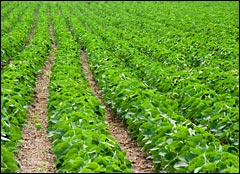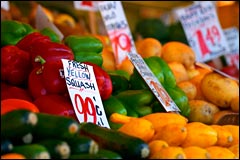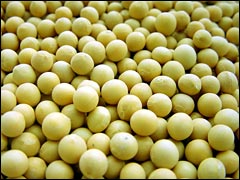Crying not for Argentina but for lost patent fees, Monsanto’s legal hacks are in European courts suing to block millions of tons of Argentine soybean meal from docking on the continent.

Bean there, sprayed that.
Photo: iStockphoto
Monsanto says that much of the meal crossing the Atlantic to feed Europe’s cows and pigs contains traces of its genetically modified Roundup Ready Soybeans. Known as RR, the soybeans are tweaked to withstand the company’s Roundup herbicide. This resistance lets farmers blanket entire fields with the chemical mixture rather than surgically applying it to kill off weeds.
Monsanto holds a patent for the seed in Europe, but not in Argentina, where a dispute over technology rights keeps the U.S.-based agri-giant from collecting technology fees on RR seed sales. By using its European patent to disrupt Argentina’s lucrative soy-meal trade with Europe, the company hopes to strong-arm Argentine farmers into paying up.
Meanwhile, the tricky lawyering is shedding light on what critics say is a dubious corporate strategy to make Argentina a mega-lab for GM soybeans, one that’s already spawned deep environmental and economic problems far off the radar screen of the international media.
The Patent Play
Walking into the Social Forum for the Resistance Against Industrialized Agriculture in downtown Buenos Aires last month, I wasn’t sure what to expect. Instead of suits and ties, I found lots of facial hair and rumpled clothes — technology wonks, students, professors, scientists, and landless peasant farmers gathered to protest the sins of large-scale industrial agriculture. One middle-aged water-quality activist wore a papier-mâché spigot on his head. An interpretive artist twirled a rubber hose and let out angry groans. Though less legible than the speakers’ PowerPoints, her message seemed thematically congruent: the soy is hitting the fan in Argentina — and Monsanto’s bad behavior is to blame.
I got a café cortado and searched out Adolfo Boy, an agronomist with the Grupo de Reflexion Rural, a technology watchdog group. “Ask yourself why Monsanto, with all its lawyers, never got a patent for gene RR in Argentina,” he said, thumbing through a binder exploding with dated newspaper clips.
He rewound to the 1990s, when the firm brought its new genetically tweaked seeds to Argentina. His theory — shared by many here — is that Monsanto intentionally left RR seeds in the public domain so Argentine farmers would use them, spread them, create new plant varieties, and, most important, lock themselves into buying the pricey Roundup herbicide.
Argentina first approved RR seeds in 1996, and Monsanto tried to build its royalty fees into the price, but a thriving black market kept the seed prices too low for the company to recoup the fees. Meanwhile, up in the land of strong patent enforcement, U.S. farmers were paying a $6.50 patent-based technology fee every time they bought a 50-pound bag of RR seed. Around that time, seeds that sold for $9 a bag in Argentina were going for $21.50 in the United States. A report issued at the time by the U.S. government’s General Accounting Office blamed the price difference on lack of property-rights enforcement in Argentina. The American Soybean Association asked Monsanto to refund more than $300 million to U.S. farmers. The company refused.
As Argentina struggled to recover from a devastating economic collapse that hit in 2001, the illegal trade in RR seeds grew. By 2005, according to one estimate, only 20 percent of Argentina’s $1 billion annual soybean seed trade was legal. Monsanto had had enough. It stopped direct seed sales in 2003, though Argentine companies continued to sell seeds containing RR genes and paid some licensing fees.
Having missed out on the chance to collect fees at the point of sale, Monsanto lawyers in 2004 said the company would charge a $1-per-ton export fee on Argentine soy and soy derivatives shipped abroad (and $2.50 per ton between 2006 and 2011). Argentina’s farmers and government officials refused.
Monsanto has denied that it made a strategic decision not to pursue patent rights in Argentina. It didn’t respond to requests for comment for this story, but in an open letter published in an Argentine paper, El Clarin, Monsanto rebuffed the public-domain theory, claiming the company tried to get a patent but was blocked by legalities.
Evidence suggests otherwise: as farmers were getting to know its RR seeds, Monsanto did not object — as Argentine law allows it to do — when farmers registered some 200 plant varieties containing Monsanto’s RR technology with the National Seed Institute, according to a report by the French newspaper Le Monde Diplomatic. Had Monsanto been truly interested in exercising legal rights over RR seed, the theory goes, it would have made use of the law, stopping others from incorporating it in other varieties.
Monocultural a Manos
What’s clearer than Monsanto’s patent strategy is the astounding rate at which the RR soybean took hold, and the repercussions it has wrought.
Since RR was approved for use here in 1996, Argentine jungles and savannas have been cleared to make room for more than 34 million acres of the crop. The rate at which forests in northern Argentina are being turned into soy plantations is three to six times higher than the world average, and the country now ranks second only to the United States as the biggest producer of GM crops in the world.
As GM operations push out traditional farming here, civil and environmental groups are crying foul, making Argentina a case study for the technology’s unintended economic, social, and environmental consequences. Agronomists say the herbicide-resistant soybean is leading to serious problems, including deforestation, soil degradation, pesticide pollution, and genetic contamination.

Soybean fields forever.
Photo: iStockphoto
“Argentina is placing its future economy and food security in danger by choosing to ignore the ecological downside of such heavy reliance on a no-till, herbicide-based system,” said Charles Benbrook, an agronomist and consultant who worked for the Carter administration and conducted a study in 2005 on GM soy’s impacts in Argentina. “They are going to run into serious problems.”
GM cheerleaders say the crops enhance food security, feeding the hungry masses with higher yield power. But statistics fall crossways. Walter Pengue of the University of Buenos Aires and Miguel Altieri of the University of California-Berkeley report that wheat, dairy, and fruit production has dropped significantly in Argentina as farmland has turned to soybean monoculture.
Monsanto claims RR soybeans decrease the need for repeated herbicide applications. But some weeds build resistance to herbicides, and when they do, different herbicides are needed in the mix. Pengue and Altieri report that in the Argentinean pampas, eight species of weeds exhibit resistance to glyphosate, the active ingredient in Roundup. The fear: the more plants become resistant, the more farmers turn to different pesticides, further complicating the soup of poisons being spread through the country’s fields.
There are also concerns that all this genetic tinkering is causing GM soy to have lower protein levels than regular varieties. A study published in the Journal of Agricultural and Food Chemistry in 2004 analyzed soybeans and soybean meal from the world’s top producers: Argentina, Brazil, China, India, and the U.S. Those from Argentina, which Benbrook says at the time were 98 percent Roundup Ready, had the lowest crude protein content. Those from China, which grew no GM soy at the time, had the highest. “This points directly to the possibility that RR has resulted in significant decline in protein level,” Benbrook said, adding that it mirrors concerns that protein levels in soy and corn in the United States are decreasing.
Meanwhile, experts say that GM crops may be playing a role in rising social dislocation. In 1998 there were 422,000 producers or local farmers in Argentina; by 2002, that number had dropped by 25 percent to 318,000.
And there are health worries stemming from the widespread use of Roundup, which has reportedly been sprayed aerially and drifted onto non-RR crops and into communities. Dario Gianfelici, a general physician from the small town of Cerrito in a soy farming region, says he has seen medical problems in farmhands that stem from herbicide exposure. “I don’t have the money or the manpower to [raise awareness] like I would like to do,” he said in a telephone interview, “but I continue to talk about this.”
Attention, Class
With people like Gianfelici and Boy sounding alarms, Monsanto is scrambling to bolster its public image. To create a new generation of customers friendly to the idea of consuming GM products, it has joined the likes of Bayer S.A. and Dow AgroSciences Argentina S.A. in funding ArgenBio, a trade association that offers teacher workshops and downloadable educational materials for use in Argentine schools. Gabriela Levitus, ArgenBio’s director, says the group’s purpose is “to divulge information about biotechnology.”
One woman’s information is another woman’s propaganda. Said Silvie Sieb, a grade-school teacher from the province of Entre Rios who attended one of the workshops, “It’s pure show business so they can turn kids into customers.”
Sieb said the presenters explained how “inofensivo” the RR soybeans and Roundup herbicide are. But, she said, “They did not say that it is destroying our soil and reducing biological and productive diversity with a monoculture cultivation that serves to feed the pigs of Europe and Asia, and next the cars of Europe with soy-based biodiesel.”
Meanwhile, over in Europe, a body of the European Union released a nonbinding decision in August saying it disagrees with Monsanto’s claims that soy meal derived from genetically modified seeds infringes the company’s patents. But Monsanto’s lawyers are still beavering away, undeterred.




